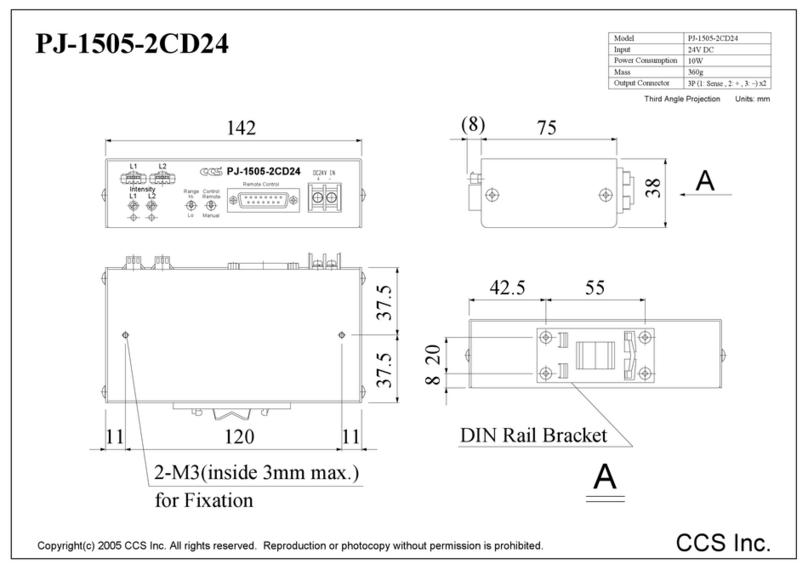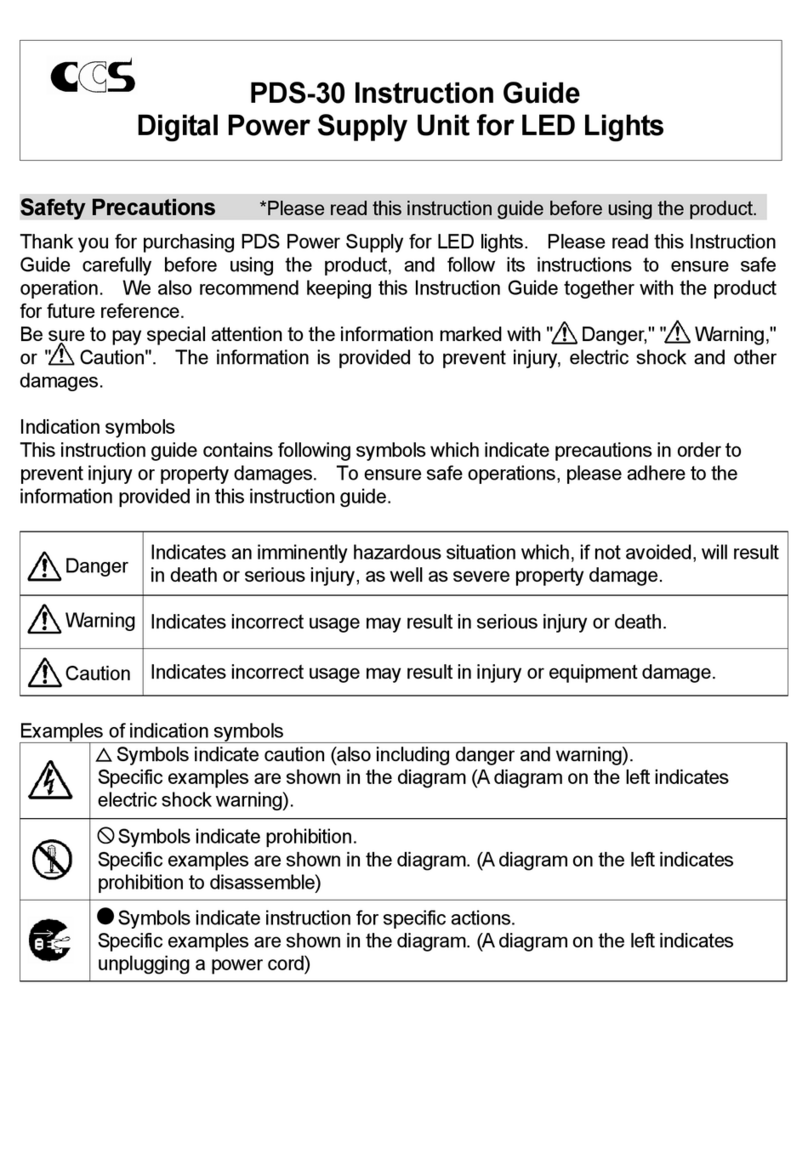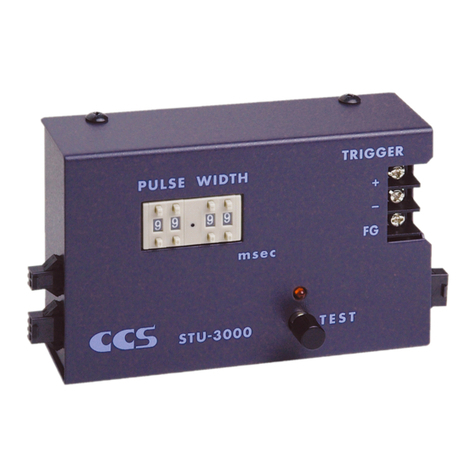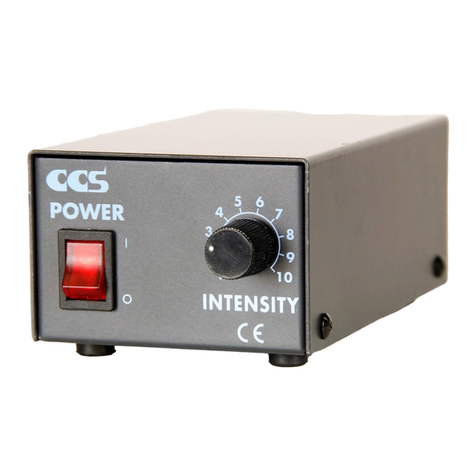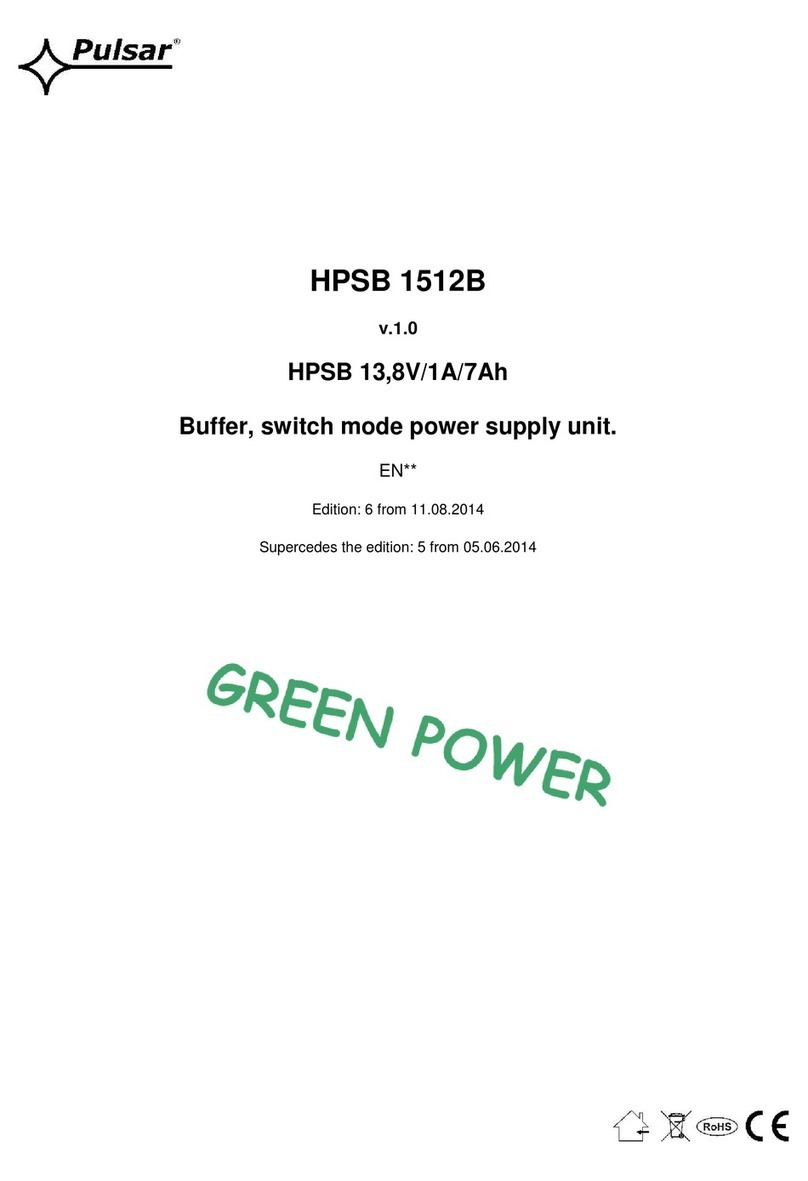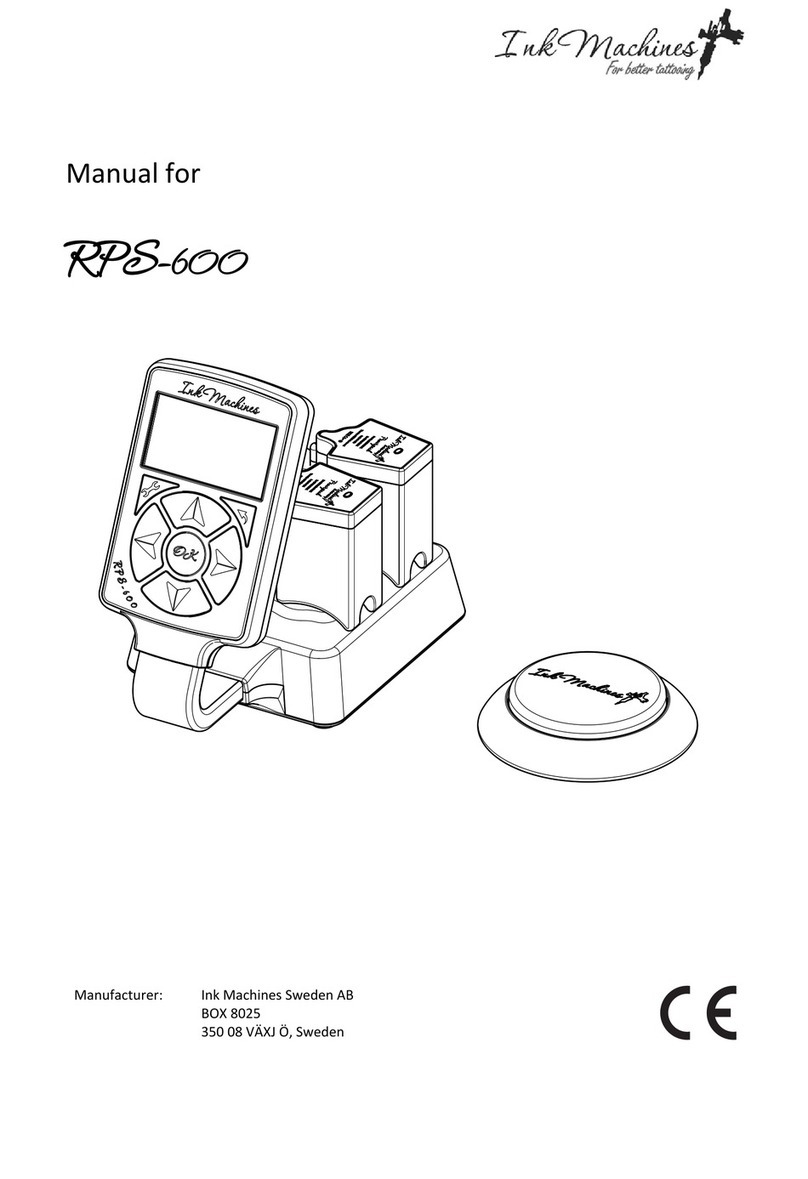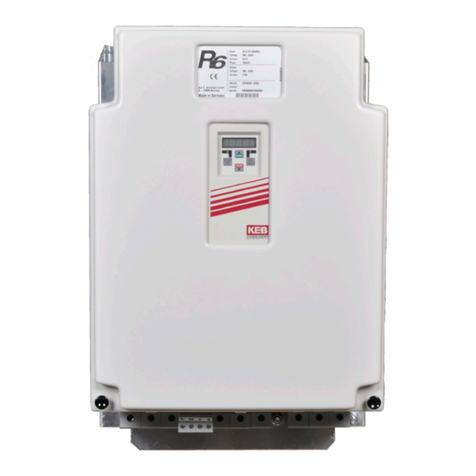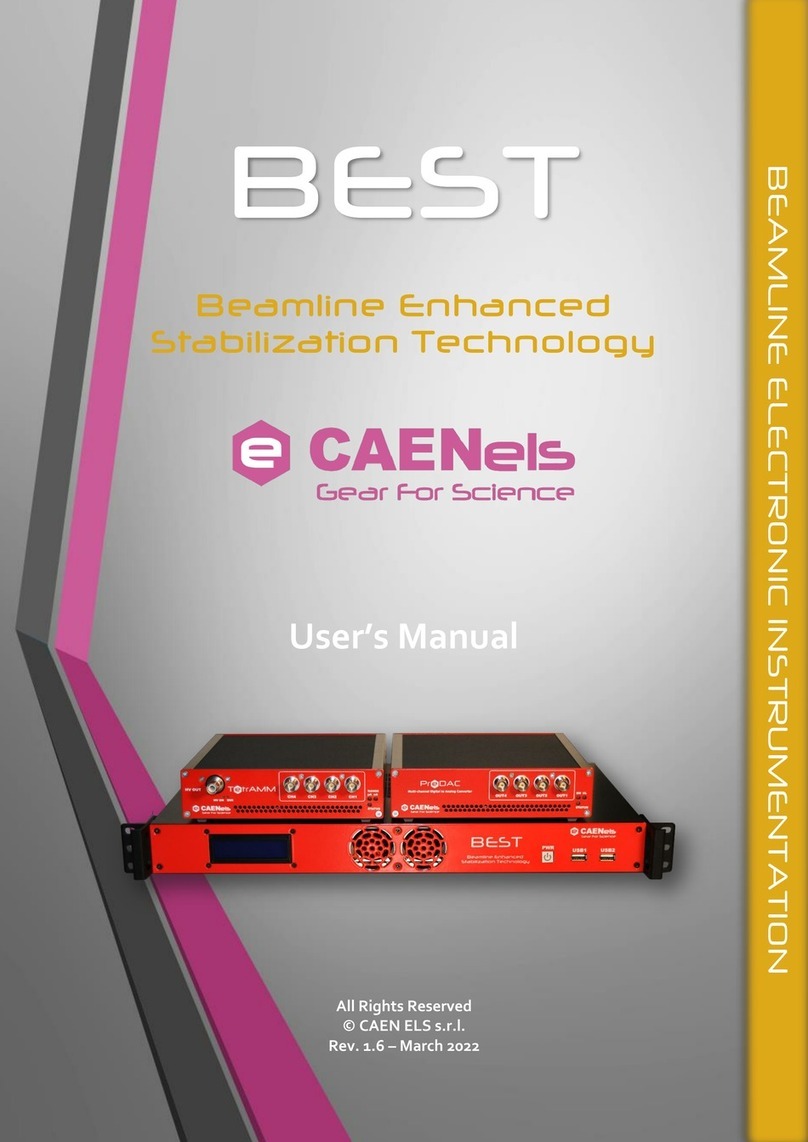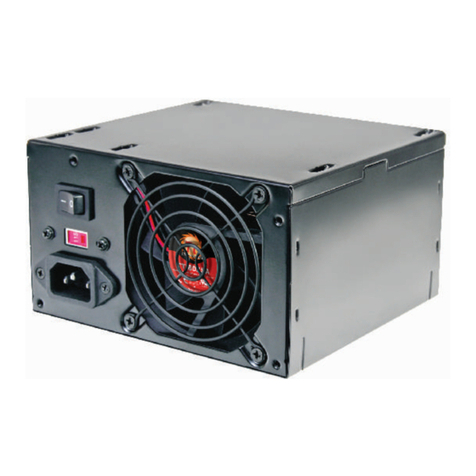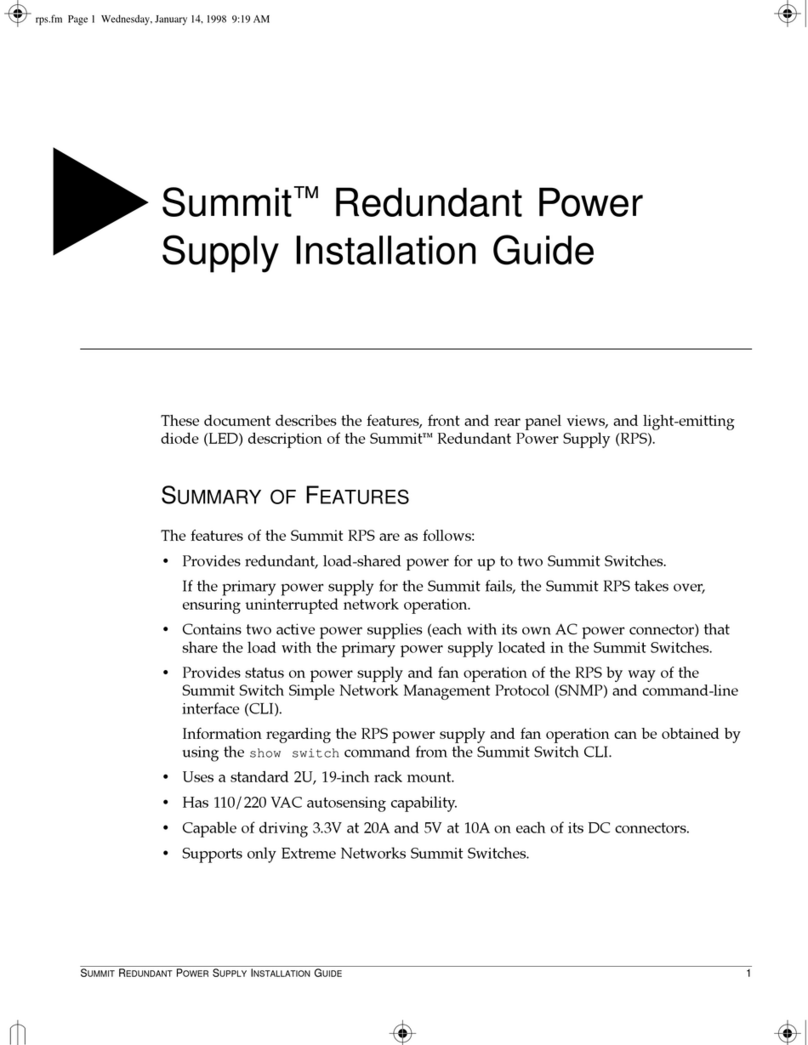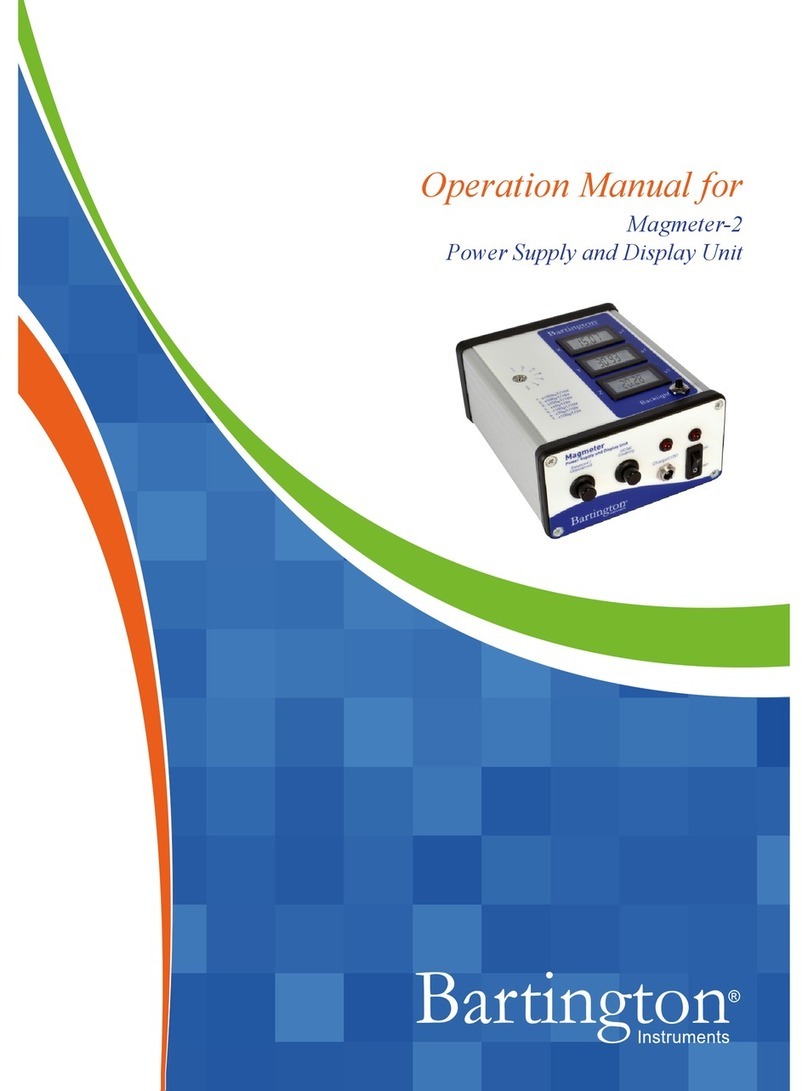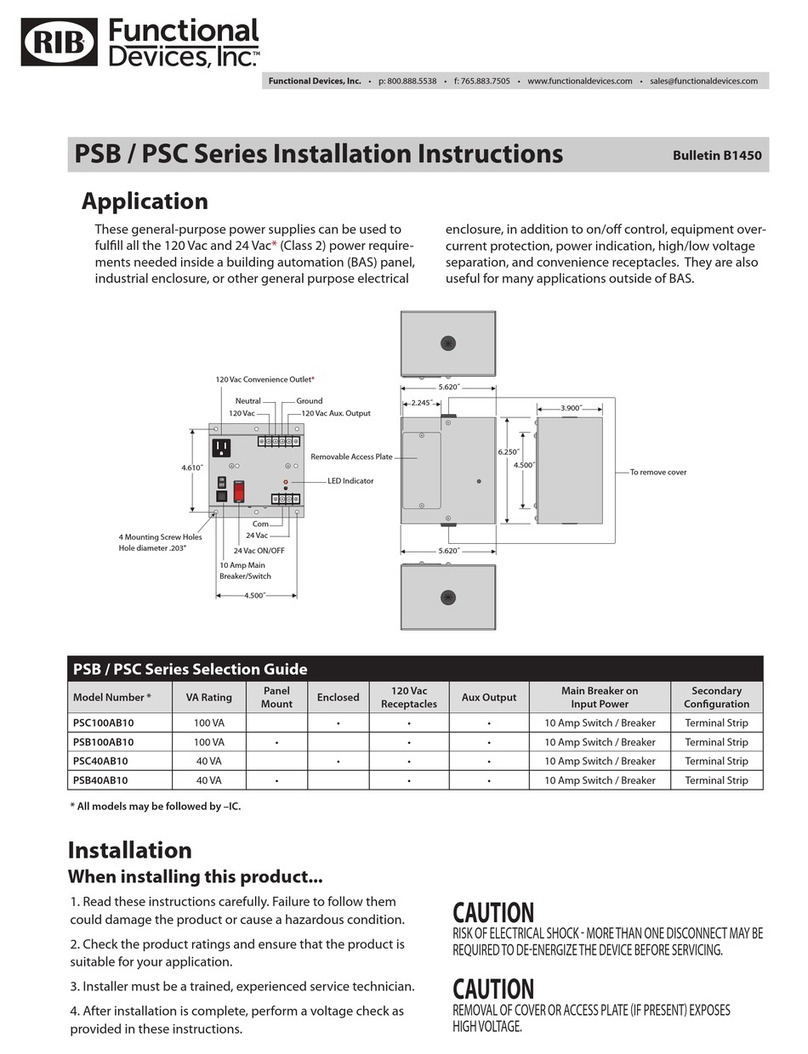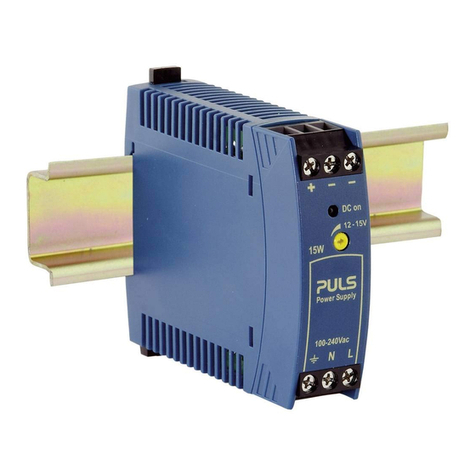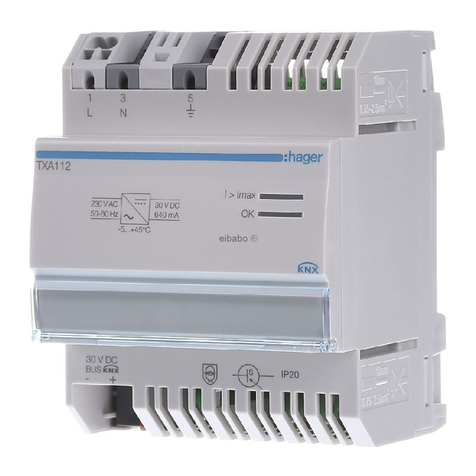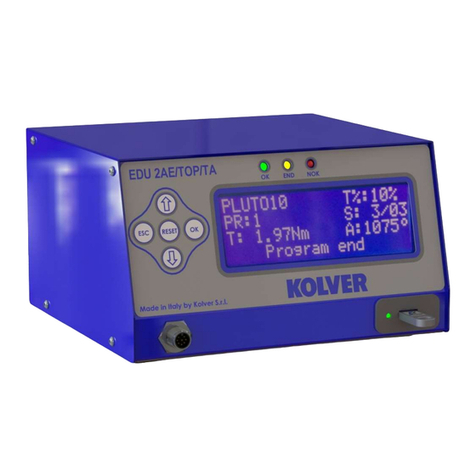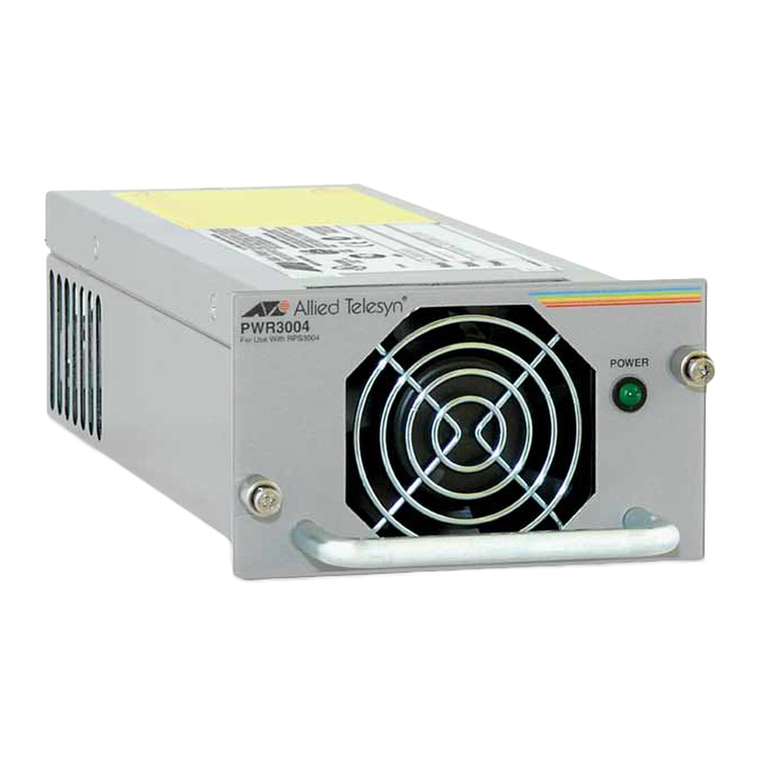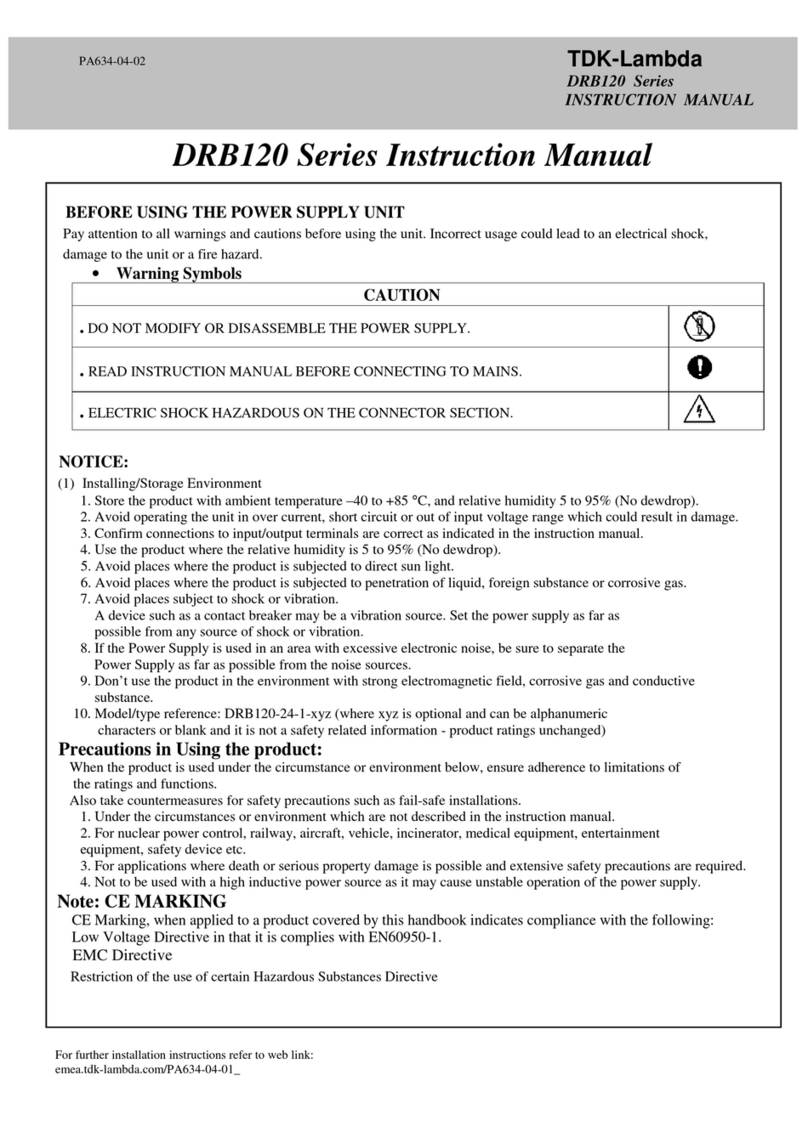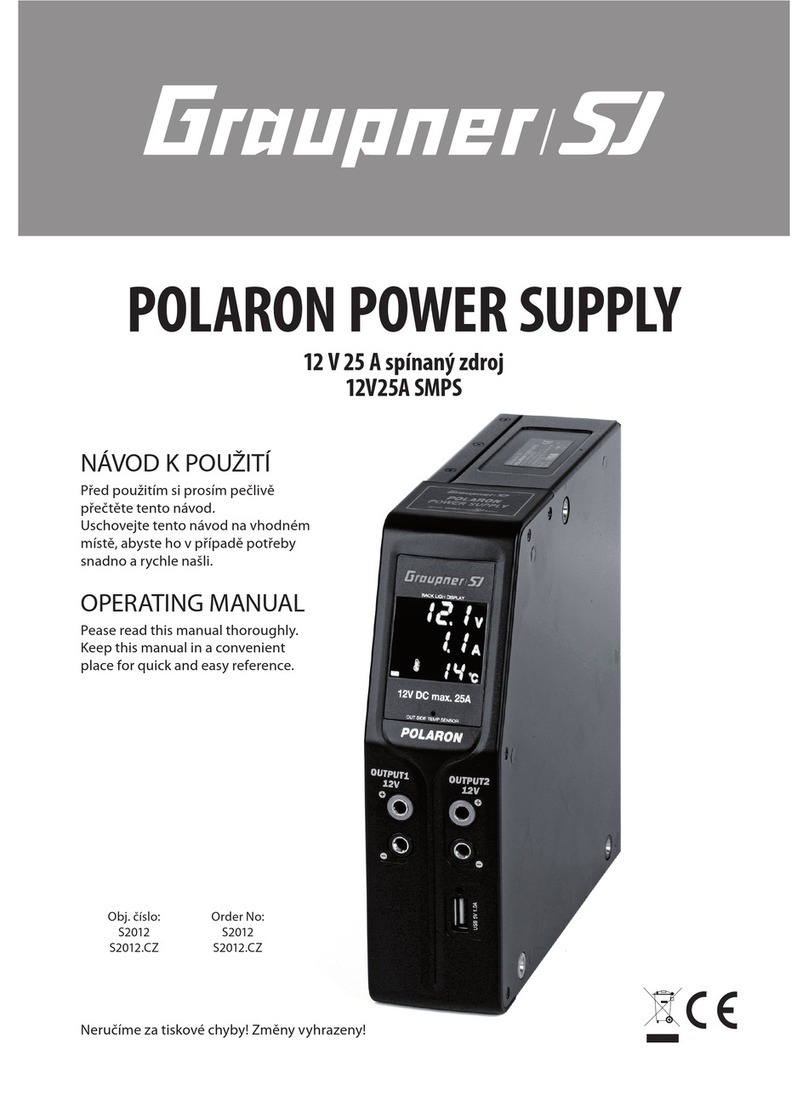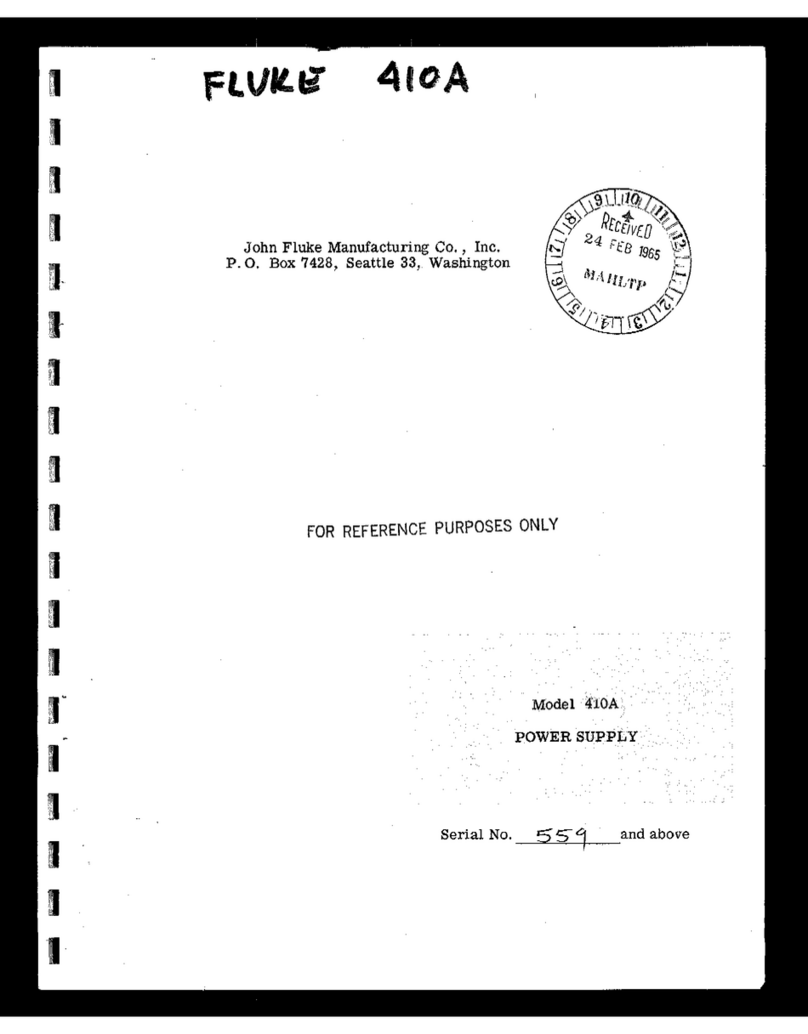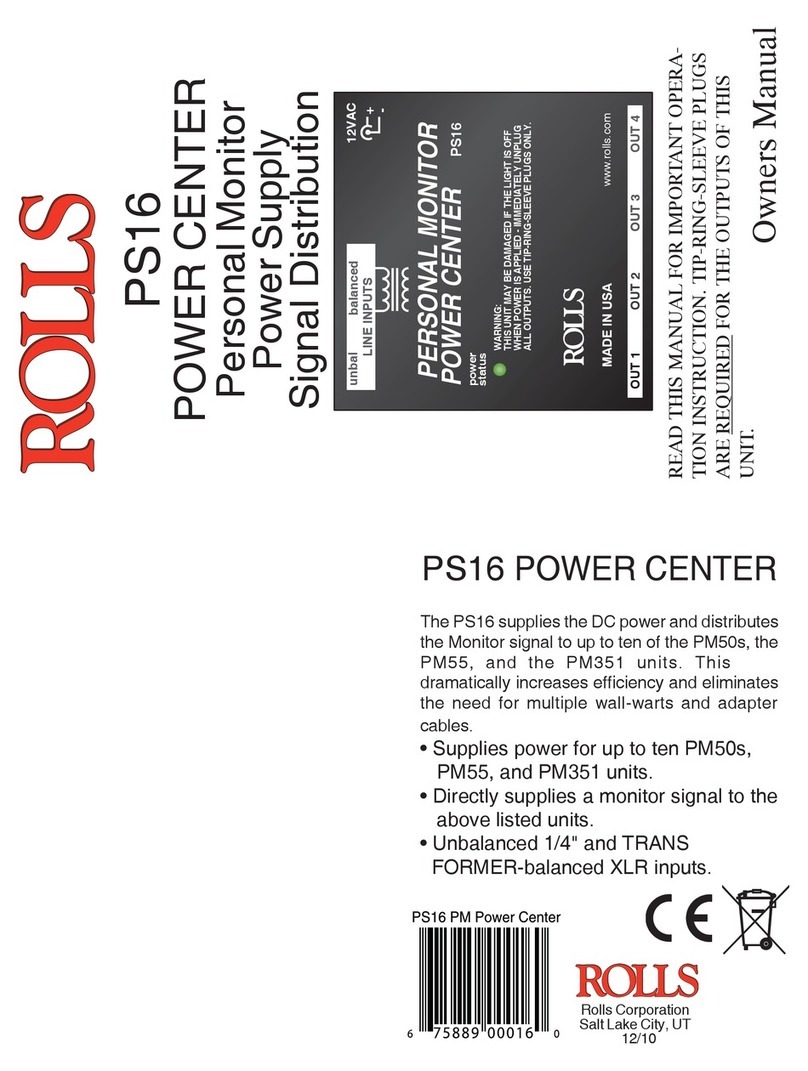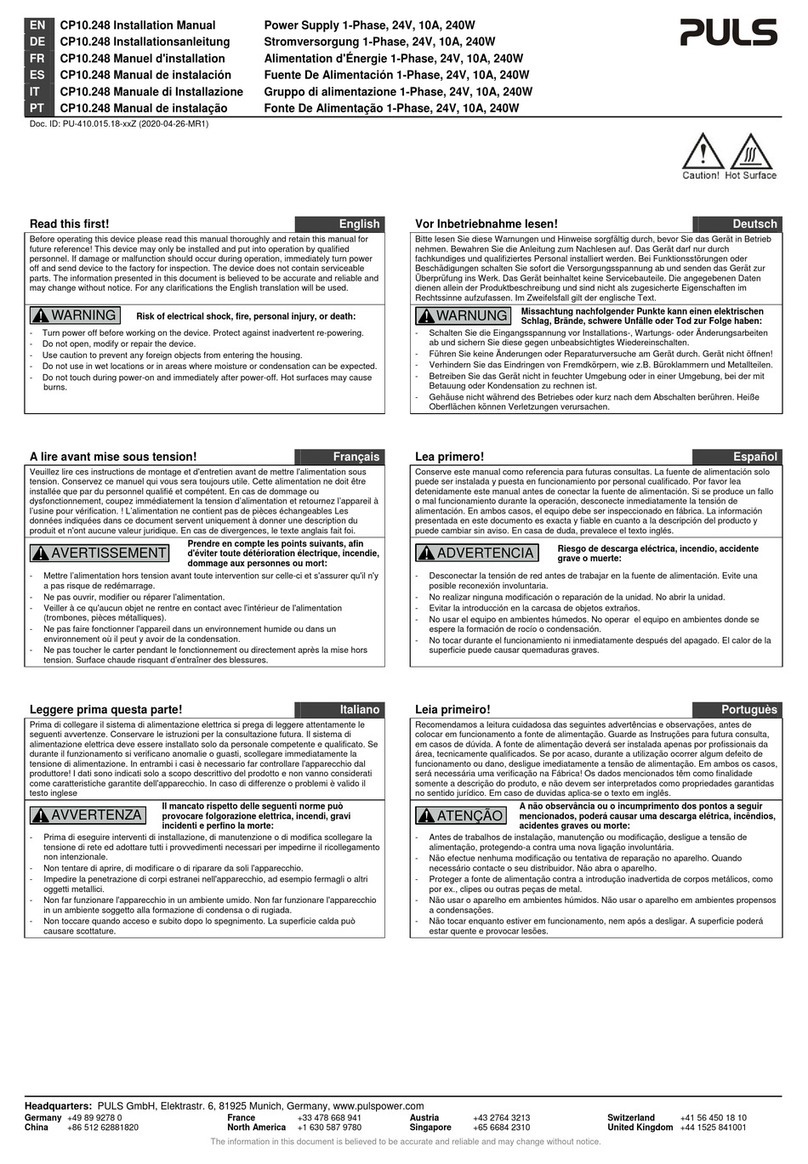CCS PFB3-20SW-SJT Series User manual

User Manual
Thank you for purchasing a CCS product. In order
to properly use this product, please read this User
Manual before using and keep it for future reference.
PFB3-20SW-SJT(A)
Series
Introduction
Important Equipment Safety
Information
Name and Function of Each Part
Installation
Connecting Cables
Preparation Capture Images
Manual Operation
Remote Operation
Reference
Troubleshooting
Main Specications
Page 1
Page 3
Page 5
Page 7
Page 9
Page 14
Page 15
Page 16
Page 19
Page 21
Page 22
HYPER
LED Light Source

Introduction Important
Equipment Safety
Information
Name and
Function of
Each Part
Installation Connecting
Cables
Preparation
Capture Images
Manual
Operation
Main
Specications
Troubleshooting
ReferenceRemote
Operation
1
Introduction
Introduction
•This HYPER LED Light Source Unit is mainly used as a light source for image processing
and industrial inspection. It is used with a Light Guide attached. This enables a high
output and the selection of a lighting pattern that is suitable for the application.
•This HYPER LED Light Source Unit is compatible with 16 dierent models of Light Guides.
(Refer to the HYPER LED Light Source Lineup on page 2.)
• The light intensity is controlled using a variable current control method.
• The light intensity can be manually controlled by adjusting the intensity control knob, or
can be externally controlled using a PLC or image processing device.
• The light intensity can be controlled or turned light ON/OFF through external control.
Features
External control cable AC adaptor
AC adaptor or power cable
External control cable
(Used when external control is required)
Light guide
(You can use your current Light Guide.)
Optional items, sold separately
Image Figure

Introduction
Important
Equipment Safety
Information
Name and
Function of
Each Part Installation
Connecting
Cables
Preparation
Capture Images
Manual
Operation
Main
Specications
Troubleshooting
Reference
Remote
Operation
2
Introduction
Do not use the product in the following conditions.
• Conditions or an environment not described in this User Manual.
• For nuclear power control, railways, aircraft, any other vehicles, combustion equipment, medical
applications, amusement devices, or safety devices.
• Situations in which there is a large and foreseeable risk to life and/or property, particularly applications
demanding a high level of safety.
Models
PFB3-20SW-SJT-MO(A)
PFB3-20SW-SJT-SH1(A)
PFB3-20SW-SJT-DJ4(A)
PFB3-20SW-SJT-IT(A)
PFB3-20SW-SJT-NP(A)
PFB3-20SW-SJT-SH2(A)
PFB3-20SW-SJT-TE(A)
PFB3-20SW-SJT-MI(A)
PFB3-20SW-SJT-DJ1(A)
PFB3-20SW-SJT-CS1(A)
PFB3-20SW-SJT-HY(A)
PFB3-20SW-SJT-DJ2(A)
PFB3-20SW-SJT-TF(A)
PFB3-20SW-SJT-SU(A)
PFB3-20SW-SJT-DJ3(A)
PFB3-20SW-SJT-VL(A)
HYPER LED Light Source (PFB3-20SW-SJT(A) Series) Lineup
Sixteen models with dierently shaped light guide adaptors are available in the product
lineup. The user can select a model which is suitable for the light guide being used.
(Refer to page 9 for a table of applicable models for various Light Guide dimensions.)
LED Light Source Unit (Main Unit) User Manual
User Manual
Thank you for purchasing a CCS product. In or der
to properly use this product, pleas e read this User
Manual before using and keep it for future reference.
PFB3-20SW-SJT(A)
Series
Introduction
Important Equipment Safety
Information
Name and Function of Each Par t
Installation
Connecting Cables
Preparation Capture Images
Manual Operation
Remote Operation
Reference
Troubleshooting
Main Specications
Page 1
Page 3
Page 5
Page 7
Page 9
Page 14
Page 15
Page 16
Page 19
Page 21
Page 22
HYPER
LED Light Source
Checking the Product and Its Accessories
Before installing the product, please check that all the items shown below are included in
your product package. If any of these items are missing, please contact CCS Inc.

Introduction Name and
Function of
Each Part
Installation Connecting
Cables
Preparation
Capture Images
Manual
Operation
Main
Specications
Troubleshooting
ReferenceRemote
Operation
3
Important Equipment Safety Information
Important Equipment Safety Information
This product has been designed with full consideration of safety. However,
incorrectncorrect usage of the product may result in fire, electric shock, or
other serious damage. Please ensure to follow the conditions below.
Warning
Indicates that incorrect usage may result in serious injury or death.
Caution
Indicates that incorrect usage may result in injury or property damage.
Symbol descriptions
Warning
MANDATORY
ACTIONS
LED light radiation may cause corneal or retinal abnormalities if you look
directly at the light. To prevent harmful light exposure, never look directly at
the LED light.
DISASSEMBLY
PROHIBITED
Do not disassemble or modify the product. Doing so may result in fire or
electric shock.
FIRE HAZARD
Turn the power supply OFF when connecting or disconnecting the product
and peripherals. Failure to do so may results in re or electric shock.
DO NOT SUBJECT
TO MOISTURE
Make sure that the product is free of moisture or any liquid. Exposure to water
may result in re, electric shock, or product failure.
DO NOT TOUCH
WITH WET HANDS
Do not touch the terminals, plugs, or switches with wet hands. Doing so may
result in electric shock.
SHOCK HAZARD
Do not touch the power supply cords or connect peripheral devices during
lightning. This may result in electric shock.
UNPLUG
If abnormal condition occurs, such as fuming, high product temperature,
smell, noise, or so on, stop using the product immediately, and turn the power
OFF. A re or electric shock may result if the product is kept used.
Please read "Symbol examples" carefully for safe usage of products.
FIRE HAZARD
symbols indicate cautions (also including danger and warning). Specific
examples are shown in diagrams. (The diagram on the left indicates re warning).
DISASSEMBLY
PROHIBITED
symbols indicate prohibition. Specic examples are shown in diagrams.
(The diagram on the left indicates prohibition to disassemble).
UNPLUG
symbols indicate required actions. Specic examples are shown in diagrams.
(The diagram on the left indicates unplugging a power cord).
Symbol examples
-Read Before Use-
-Read Before Use-
Important
Equipment Safety
Information

Introduction
Name and
Function of
Each Part Installation
Connecting
Cables
Preparation
Capture Images
Manual
Operation
Main
Specications
Troubleshooting
Reference
Remote
Operation
4
Important Equipment Safety Information
Caution
FIRE HAZARD
Always use one of the following power cord when using the AC adaptor.
100 to 120V range: SVT or SJT type, AWG18, length: 3m max., dielectric strength: 125V min.
200 to 240V range: H05VV-F type, AWG18, length: 3m max., dielectric strength: 250V min.
FIRE HAZARD
Do not place product under direct sunlight or in a high humidity environment.
Doing so may result in re due to internal temperature rise.
PROHIBITED
Always place product on a stable and at location. Not doing so may result in
the product falling or toppling, which may cause bodily injury.
MANDATORY
ACTIONS
Please use designated power sources with stable voltage. Sharing a power
source with inverters, motors, etc. may cause malfunction.
MANDATORY
ACTIONS
Make sure that the light guide to be connected matches the product's
specications and dimensions. Using a light guide that does not match the
product's specications and dimensions may result in product failure.
MANDATORY
ACTIONS
Do not bundle product cables with high-voltage lines or power lines. Doing so
may cause the product to malfunction. Keep the product cables as far away
from such lines as possible.
MANDATORY
ACTIONS
Do not bend or jam cables when wiring product. Doing so may result in
product failure.
MANDATORY
ACTIONS
Before moving product, disconnect cables. Damaging the cables may result
in re or electric shock.
PROHIBITED
Do not disconnect cables or disassemble product while operating. Doing so
may result in product failure.
MANDATORY
ACTIONS
Make sure to hold and pull from the plugs when disconnecting the cables.
Not pulling from the plugs may damage the cable and result in re or electric
shock.
MANDATORY
ACTIONS
Use a dry cloth to remove dust or other foreign matter from the plug electrodes
of power supply cables. Failure to do so may result in re.
PROHIBITED
Do not drop or subject the product to impact. Doing so may result in product
failure.
PROHIBITED
To avoid product surface discoloration or deterioration, do not wipe product
with volatiles such as paint thinner or benzene.
Important
Equipment Safety
Information

Introduction Important
Equipment Safety
Information
Installation Connecting
Cables
Preparation
Capture Images
Manual
Operation
Main
Specications
Troubleshooting
ReferenceRemote
Operation
5
Name and Function of Each Part
Name and Function of Each Part
Light Source Unit
Power switch
Power indicator lamp
Fan air inlets
Remote/Manual selection switch
Light guide insertion port
The LED light source is
located behind the light
guide insertion port.
Screw for securing the
light guide
Error indicator lamp
Light guide attachment
adaptor
16 types of adaptors are
available.
Terminal block
Fan air inlets
DC jack
Fan exhaust outlets
External control connector
Light intensity control knob
Front
Rear
Name and
Function of
Each Part

Introduction
Important
Equipment Safety
Information Installation
Connecting
Cables
Preparation
Capture Images
Manual
Operation
Main
Specications
Troubleshooting
Reference
Remote
Operation
6
Name and Function of Each Part
12345
6789
Connectors
External Control Connector
Terminal block
Pin name Signal
+ 24V DC
-
GND
DC jack
Center plus
Power Input Connector
#4-40UNC inch thread
9-pin D-sub
Name and
Function of
Each Part
Pin number Signal Function
1 NC Not connected
2 RXD Receive command
3 TXD Send command
4 NC Not connected
5 GND Connect to external ground
6 NC Not connected
7RTS Connect to pin 8
8 CTS Connect to pin 7
9 NC Not connected
An optional CCS external control cable EXCB2-9-9-3-ST (a 3m long cable with a connector)
is sold separately.
The user may prepare a shielded control cable as long as the length does not exceed 3m.

Introduction Important
Equipment Safety
Information
Name and
Function of
Each Part
Connecting
Cables
Preparation
Capture Images
Manual
Operation
Main
Specications
Troubleshooting
ReferenceRemote
Operation
7
Installation
Installation
Do not block the fan air inlets or fan exhaust outlets. Insufficient
ventilation may cause heat to accumulate inside the product and
result in a re.
Warning
Do not place any objects within
50mm from the fan air inlet.
MANDATORY
ACTIONS
Do not place any objects within
50mm from the fan exhaust outlet.
MANDATORY
ACTIONS
Installation Environment
Please use products in locations with following conditions. Incorrect
installation location may cause product failure.
Caution
• On a at and stable location with minimal vibration.
• Well ventilated places with minimal dust.
• Places free from corrosive or combustible gas.
• Places away from water faucets, boilers, humidiers, air conditioners, heaters, or stoves
.
• Places that are not subject to sudden temperature changes.
Leave a space
of at least 50mm
from the fan
exhaust outlet
Leave a space
of at least 50mm
from the fan air
inlet
Do not block the
fan.
Do not place
the product on
its side.
Installation

Introduction
Important
Equipment Safety
Information
Name and
Function of
Each Part
Connecting
Cables
Preparation
Capture Images
Manual
Operation
Main
Specications
Troubleshooting
Reference
Remote
Operation
8
Installation
Holding xtures Installation screw holes
HNTTSN5-3 M3
HNTTSN5-4 M4
HNTTSN5-5 M5
*
Recommended holding fixture types
(mfd. by Misumi)
Installation screw (M4)
Installation screw hole
(Insert depth of 6mm max.)
(Tightening torque: 0.3N•M max.)
Making the Unit Secure
Securing the Side
Securing the Bottom
Insert holding xture into the slit on the side of the unit.
Tighten the installation screws to secure the unit.
Note: The holding xture, installation screws, and stationary plate must be provided by the user.
Remove the rubber feet from the bottom of the unit.
Use a hex wrench to remove the rubber feet attachment bolts.
Tighten the installation screws to secure the unit.
Note: The installation screws must be provided by the user.
1
1
2
2
1
2
Installation screws
Stationary plate
* Holding xture
1
2
Rubber foot
Rubber feet attachment bolt (CAP, M3)
Installation

Introduction Important
Equipment Safety
Information
Name and
Function of
Each Part
Installation Preparation
Capture Images
Manual
Operation
Main
Specications
Troubleshooting
ReferenceRemote
Operation
9
Connecting Cables
Connecting Cables
Before connection, make sure that the power is turned OFF. Making
connections with the power ON may result in a re or electric shock.
Warning
Light guide dimensions Applicable models
PFB3-20SW-
SJT(A)
Insertion tip diameter (mm)
Insertion tip length (mm)
1 2
15.875 31.65 -IT
Light guide dimensions Applicable models
PFB3-20SW-
SJT(A)
Insertion tip diameter (mm)
Insertion tip length (mm)
123456
13 20 25 15 30 30 -SU
15.9 18.2 22 .1 6.4 18.3 32.7 -SH1
Light guide dimensions Applicable models
PFB3-20SW-
SJT(A)
Insertion tip diameter (mm)
Insertion tip length (mm)
1234
15 25 to 32 37 30 to 48 -MO
15 25 to 35 31 23.5 to 80 -NP
15 20 to 31 21 30 to 40 -MI
15 25 to 40 20 30 to 70 -HY
15 18 22.2 17.8 -VL
15 25 to 30 30 25 to 30 -TF
15.87 18 12.7 18.5 -TE
18.24 22 25 32.5 -SH2
7.92 10.72 12.7 14.2 -DJ1
14.27 15.6 12.7 19.6 -DJ2
11.13 15.86 12.7 25.45 -DJ3
4.72 6.35 12.7 14.2 -DJ4
814 12 12 to 23 -CS1
Check the model of the PFB3-20SW-SJT(A) that you purchased and then select an
applicable Light Guide from the following table.
Insert the Light Guide
Checking the Light Guide
Type 1
Type 2
Type 3
Connecting
Cables

Introduction
Important
Equipment Safety
Information
Name and
Function of
Each Part Installation
Preparation
Capture Images
Manual
Operation
Main
Specications
Troubleshooting
Reference
Remote
Operation
10
Connecting Cables
Light guide
Screw for securing the
light guide
Macro lens
Camera
Light guide insertion port
Connecting the Light Guide
Connecting the Power Cable or AC Adaptor
Connect a power cable to the
terminal block. (The power
cable must be provided by the
user.) Refer to page 11.
Using an AC adaptor
Connect the AC adaptor to
the DC jack. (The optional AC
adaptor is sold separately.)
Refer to page 12.
Using a power cable
Insert the light guide into the insertion port, then tighten the screw to secure the light guide.
Do not connect a power cable and AC adaptor at the same time.
Caution
Light guide
attachment adaptor
Connecting
Cables

Introduction Important
Equipment Safety
Information
Name and
Function of
Each Part
Installation Preparation
Capture Images
Manual
Operation
Main
Specications
Troubleshooting
ReferenceRemote
Operation
11
Connecting Cables
Connect a power cable from a 24V DC source to the terminal block on the back of the unit.
(The power cable must be provided by the user.)
Using a Power Cable
Do not connect the power cable with the positive and negative terminals reversed.
Caution
Loosen the screw with a Philips screwdriver, attach the power cable, and retighten the screw.
2
DC24V
GND
Power cable*
Philips screwdriver
*Power cable
Be sure to connect properly with
insulated crimp terminals.
Recommended crimp terminal:
NICHIFU M3 crimp terminals with
insulating sheath
Ring or “Y” TMEV 1.25-3
Detach the terminal block cover.
1
Terminal block cover
Lift up
Terminal block
Always attach the terminal block cover to prevent short-circuits between the
positive and negative terminals. Short-circuits can damage peripheral devices.
Attach the terminal block cover.
3
Align the edge and
push downward.
edge
Caution
Connecting
Cables

Introduction
Important
Equipment Safety
Information
Name and
Function of
Each Part Installation
Preparation
Capture Images
Manual
Operation
Main
Specications
Troubleshooting
Reference
Remote
Operation
12
Connecting Cables
Connect the AC adaptor (optional item, sold separately) to the DC jack on the rear side.
Outside drawing of the AC adaptor (optional item, sold separately)
Using an AC Adaptor
DC jack
AC adaptor
Insert the adaptor all the way into the jack.
Connecting
Cables
1530
Ø5.5
Ø2.1
121
52
33
10
Center plus
AC adaptor main unit
Cord connector
IEC 60320 C6
INPUT:100 to 240 VAC 130 VA 50/60 Hz
OUTPUT:22.8 to 25.4 V 2.7A
U.S. DoE CEC Level VI External Power
Supply Efficiency Standards compliant
Model:
ADP2460-PFB-JTLV6
Unit: mm
Accessory: Power cord
Do not use any AC adaptor other than the above model. Doing so may result in product
failure. Use of the LED Light Source with any AC adaptor other than the above model is
not covered under warranty.
Caution

Introduction Important
Equipment Safety
Information
Name and
Function of
Each Part
Installation Preparation
Capture Images
Manual
Operation
Main
Specications
Troubleshooting
ReferenceRemote
Operation
13
Connecting Cables
Model: EXCB-9-9-3-ST Unit: mm
9-pin D-sub
(socket)
9-pin D-sub
(socket)
3000
2x#4-40UNC
(inch thread)
2x#4-40UNC
(inch thread)
Conforms to EIA-232.
Connect the External Control Cable (Used when external control is require)
Make sure that the product and external control equipment are turned OFF.
Refer to the page 6 connector conguration table, and connect to the external control
equipment.
Connect the external control cable (optional item, sold separately) to the external
control connector on the back of the product.
Note: External noise can cause unstable operation. Use the product in an environment with as little
noise as possible.
1
2
3
CN1 CN2
1 1
2 2
3 3
4 4
5 5
6 6
7 7
8 8
9 9
Frame Frame
PC or other terminals
PLC or other external
control equipment
External control connector
External control cable
Outside drawing of the external control cable (optional item, sold separately)
Connecting
Cables

Introduction
Important
Equipment Safety
Information
Name and
Function of
Each Part Installation
Connecting
Cables
Manual
Operation
Main
Specications
Troubleshooting
Reference
Remote
Operation
14
Preparation Capture Images
Preparation Capture Images
Turning Power ON and OFF
Preparation Capture Images
Turn ON the power.
1
Select the lens, and focus imaging devices
such as cameras, microscopes, etc. to
inspection objects.
2
Adjust radiant quantity to optimize images.
3
Push the power switch to turn
the power ON.
Push the switch again to turn
the power OFF.
When the power is turned
ON, the power indicator lamp
lights.
Do not look into the light guide insertion port with the power turned
ON. Depending on the light radiant quantity, there is a danger that
this could have an adverse eect on the eye.
Warning
Be sure to read the User Manuals for all peripheral devices before using them.
Push the power switch
Power OFF Power ON
Light guide
Macro lens
Object
Camera
Preparation
Capture Images

Introduction Important
Equipment Safety
Information
Name and
Function of
Each Part
Installation Connecting
Cables
Preparation
Capture Images
Main
Specications
Troubleshooting
ReferenceRemote
Operation
15
Manual Operation
Manual Operation
Set the Remote/Manual selection switch to the Manual position.
Adjust the intensity control knob on the front panel to set the light intensity. The light
intensity control is stepless from a minimum intensity of 1 to a maximum intensity of 10.
Note:The light intensity of this product is very
faint when the intensity control knob is set
to the minimum intensity. The product uses
a high-intensity LED, which may sometimes
flicker or go OFF when the intensity control
knob is set to the minimum intensity or close
to the minimum intensity. This results from
the characteristics of the LED, and does not
indicate a failure.
Check the Mode
Control Light Intensity
Remote / Manual
Manual
Operation

Introduction
Important
Equipment Safety
Information
Name and
Function of
Each Part Installation
Connecting
Cables
Preparation
Capture Images
Manual
Operation
Main
Specications
Troubleshooting
Reference
16
Remote Operation
Remote Operation
Note: An External Control Cable is available as an option (9-pin D-sub EIA-232 standard).
Refer to Connect the external control cable on page 13.
Note:The light intensity of this product is very faint when the intensity control knob is set to the minimum intensity.
The product uses a high-intensity LED, which may sometimes icker or go OFF when the intensity control
knob is set to the minimum intensity or close to the minimum intensity. This results from the characteristics of
the LED, and does not indicate a failure.
Check the Mode
Use External Control
Remote / Manual
Set the Remote/Manual selection switch to the Remote position.
Note: Do not switch during communications.
Type Function Details Send command Receive command (OK) Receive
command (NG)
Set
Light intensity
setting
Sets the light intensity
data
F nnn (nnn = 000 to 255)
000: Minimum light
intensity value
255: Maximum light
intensity value
(default : 000)
O
N nn (nn is the
error number)
Refer to page
18 "Errors".
Light ON/OFF
control
Turns the light ON
and OFF
Ln (n = 0/1)
0: Light OFF,1: Light ON
(default : 1)
O
Software reset Restores the default
values R O
C o n r m
Knob light
intensity value
check
Conrms the light
intensity value that
was set manually
QV O nnn (nnn = 000 to 255)
Command
light intensity
value check
Conrms the light
intensity value sent by
the command
QF O nnn (nnn = 000 to 255)
Firmware
version
Conrms the rmware
(the software that
controls the unit)
version
VO nnn
(nnn is the version number)
Status inquiry
Conrms status,
including abnormal
LED temperatures,
LED open failures,
and fan shutdown.
QS
Onnn (n=0/1 0: Normal, 1: Error)
Status is given in the following
order starting from the left:
abnormal LED temperature,
LED failure, fan status.
Remote
Operation
Connect the external control cable and send a command with reference to the following “List
of Functions” and “Communication Specications” in page 17.
* This product does not have data storage function. When cycling the power supply, it is
reset and light intensity setting or so is required again.
List of Functions

Introduction Important
Equipment Safety
Information
Name and
Function of
Each Part
Installation Connecting
Cables
Preparation
Capture Images
Manual
Operation
Main
Specications
Troubleshooting
Reference
17
Remote Operation
Communications Specications
Data bit length 8 bits
Stop bit 1
Parity check None
Baud rate 9600bps
ASCII code
Text stringProtocol
Command formats
Header Prex Command Write ag Check sum Delimiter
@00 (xed) Transmit command 0 (xed) Upper Lower CR LF
Transmit command
*
Header Prex OK/NG command Check sum Delimiter
@00 (xed) Receive command Upper Lower CR LF
Receive command
* Refer to the page 16 "List of functions".
*
The term "check sums" means what is obtained by converting command character
strings to ASCII code, and converting the value for lower 1 byte of the sum of header
to check sum position into 2-byte ASCII code.
Check sums
Header Prex Command Write ag Check sum Delimiter
@ 00 F 125 0 A E CR LF
Example: Light intensity setting command
Conversion to ASCII code
Sum 1AE H
Header Prex Command Write ag Check sum Delimiter
40 H 30 H 30 H 46 H 31 H 32 H 35 H 30H 41 H 45 H CR LF
AE H
The lower 1 byte is converted
to 2-byte ASCII code
A E
Remote
Operation

Introduction
Important
Equipment Safety
Information
Name and
Function of
Each Part Installation
Connecting
Cables
Preparation
Capture Images
Manual
Operation
Main
Specications
Troubleshooting
Reference
18
Remote Operation
If a command is not transmitted properly, the incoming command will display an error number.
Conrm the details of the error using the table below and take appropriate measures.
If errors listed below occur, the error indicator
lamp blinks. To clear the error, remove the cause
of the error and then cycle the power supply.
Errors
Malfunction Detection Functions
Command Transmission Failure
Error indicator lamp blinks
Power switch
Light source
turns OFF
Error number Details
00 Command error Not in the proper transmit
command format.
Refer to "page 17 Command
formats".
01 Check sum error The check sum values are not
correct. Refer to "page 17 Check sums".
02
Communications error
One of the following
communications errors occurred.
[Overrun]
The next data was written before
the current data was written.
[Framing error]
The stop bit was not detected.
Conrm that the external
equipment you are using and
the system within this product
are compatible. Conrm that the
protocols are compatible.
Error Details
Abnormal LED temperature error*1*2 An abnormal LED temperature occurred.
LED failure error*1 The LED blowout error detection function operated.
Fan status error*1 The fan stopped operating.
System clock shutdown error*2 The internal circuit oscillator malfunctioned.
Remote
Operation
*1
The errors can be detected by the send command (QS) externally. Refer to the page 16
"List of functions"
for details.
*2 The light source turns OFF and the error indicator lamp blinks. Immediately turn the
power switch and the power supply on the supply side OFF, and please contact
CCS Inc.

Introduction Important
Equipment Safety
Information
Name and
Function of
Each Part
Installation Connecting
Cables
Preparation
Capture Images
Manual
Operation
Main
Specications
Troubleshooting
Remote
Operation
19
Reference
Reference
Intensity control characteristics
0
20
40
60
80
100
0 20 40 60 80 100
Light intensity (%)
Radiant quantity (%)
Note:
Attach a straight light guide with a join
diameter of 8 mm and measure the value at
a position 50mm from the end of the ber
(values are not guaranteed).
Intensity Control Characteristics (reference graph)
Light ON/OFF Response Delay Time (reference values)
Reference
Delay time (typ.)
Delay time before light ON after receipt of ON control command*1 12 ms
Delay time before light OFF after receipt of OFF control command*2 8.7 ms
*1 This is the time until 90% of the maximum light amount is reached after the receipt of command.
*2 This is the time until 10% of the maximum light amount is reached after the receipt of command.
This manual suits for next models
1
Table of contents
Other CCS Power Supply manuals
